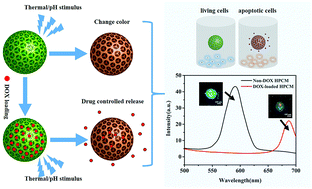Non-dye cell viability monitoring by using pH-responsive inverse opal hydrogels
Abstract
Recent advances in the field of drug screening focus on accurate, rapid and high-throughput screening methods. In our work, hydrogel inverse opal photonic crystal microspheres (HPCMs) were fabricated through a templating method and exhibited a robust and reversible response to temperature and pH. The response performance was tested under various temperature (25–55 °C) and pH (1.5–7.5) conditions and the reflective peak shifted noticeably within the visible wavelength range. Furthermore, HPCMs were used as drug delivery carriers and not only displayed high doxorubicin (DOX) drug loading but also presented thermo/pH-induced drug release properties. More importantly, these carriers were shown to be good reporters for monitoring cell viability due to their tunable colour variation. This capability was applied to H460 cell cultures with or without DOX. The structure colour of HPCMs varied in different cell culture microenvironments, and cell apoptosis was able to be distinguished. In this way, this fast, non-dyeing method for reporting cell viability in tumour cytotoxicity assays has potential in the field of drug screening and may give new insights into the use of structural colour to report results in drug screening systems.



 Please wait while we load your content...
Please wait while we load your content...